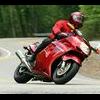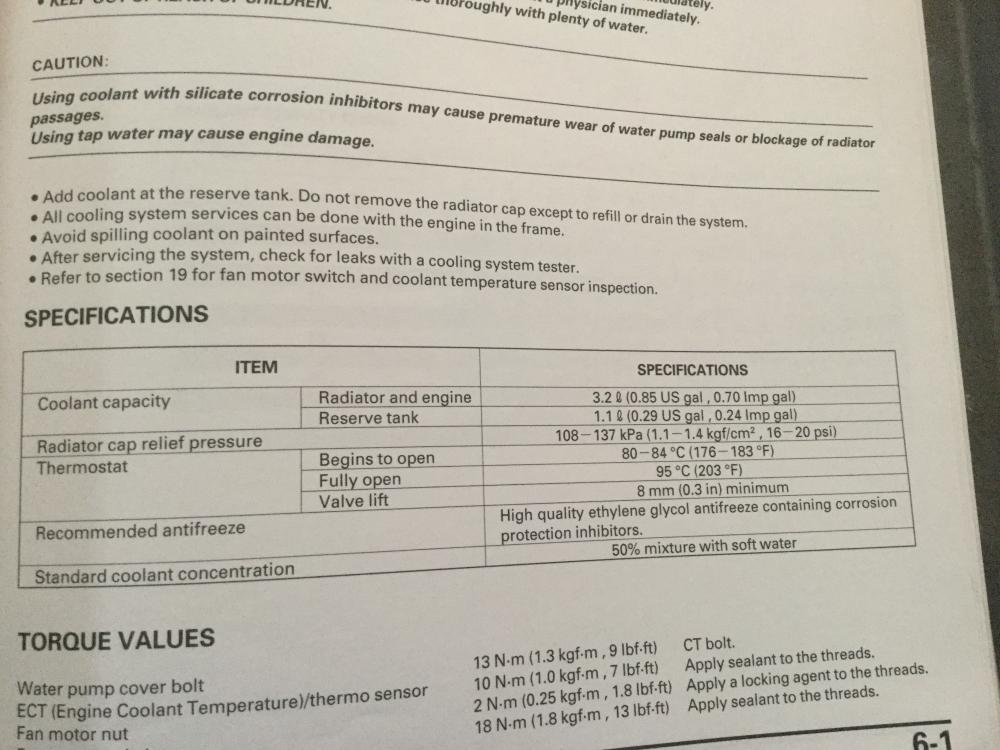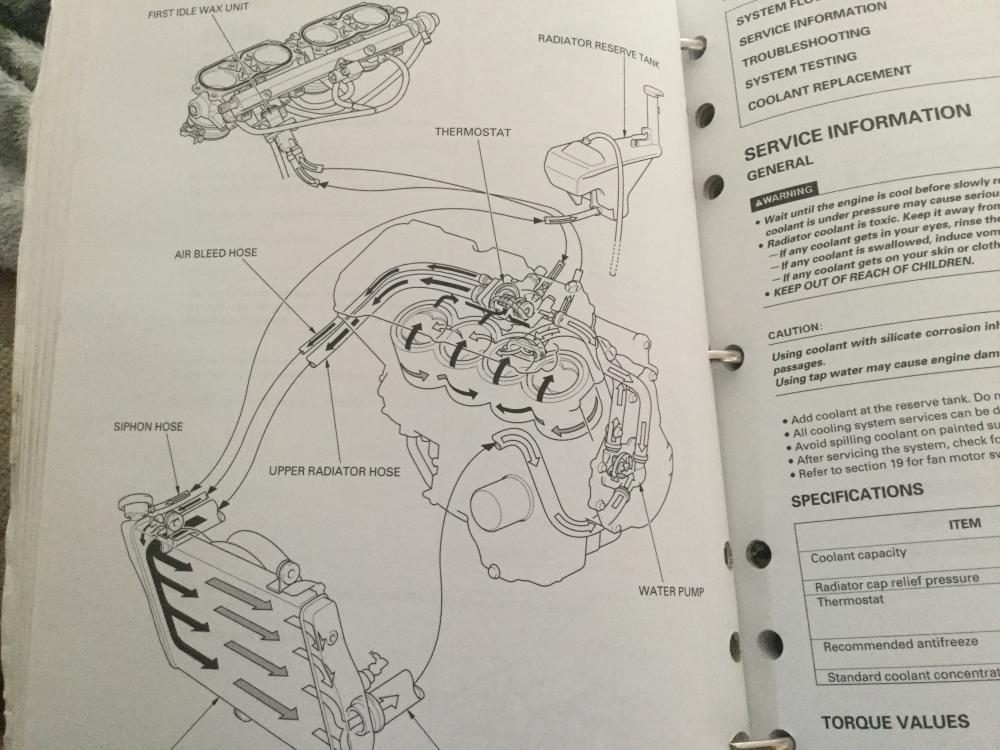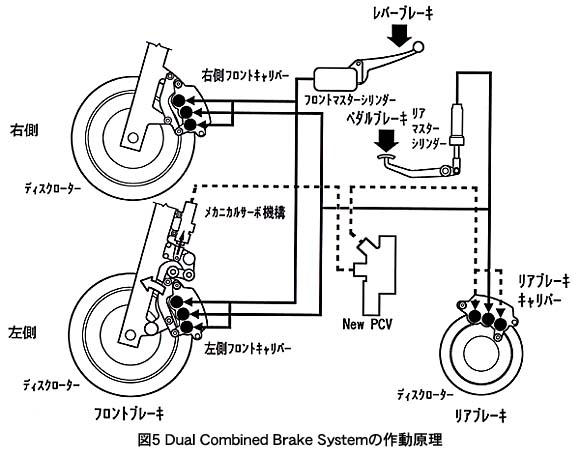-
Posts
4,398 -
Joined
-
Last visited
-
Days Won
15
Content Type
Profiles
Forums
Gallery
Events
Everything posted by redxxrdr
-
First, I haven't done a complete drain, just a flush pulling the water pump drain and a lower hose. My 01 manual shows .84 US gallon capacity. Thats allot more than the .5 you say that you drained. Not a big deal for flush, but my reading on Evans says that you need all the coolant out. I would remove the radiator cap, to eliminate pressure build, and then warm up the bike to open the thermostat. You can then drain the coolant, and prevent it from being trapped behind the thermostat. I would probably remove a lower hose, and one to the wax unit too. You are correct, the manual talks about a block ( cylinder) drain. The picture sucks. Do us a favor and post a good picture when you find it. I would reach out to Philip, or others who have done this before finishing. Now I'm going for a ride to see how mine does with a new fuel filter.
-
Yes using your ears shows you where the leak is. But % is a useful tool for many repairing expensive engines. You have posted enough that I know you understand this. But for others, many engines have leak down minimum specs, as well as balance between cylinder specs. Gone are the days of $200.00 piston / cylinder sets for aircraft, or $50.00 for VW. It is acceptable to replace one or two cylinders on certain engines, based on differential pressure testing. You can legally replace only what is needed. Plus it is a great way to track engine wear over time. A leak down tester is not the only way that a good mechanic can figure out what is going on in a engine. But it sure is handy. Especially on the larger 9-18 cylinder aircraft engines that I used to help with. The AI that I used to help always use Nitrogen for his pressure source. Dry, clean, regulated, portable, and already available since it was used to fill landing gear struts on larger planes. 😏
-
What was the failure on the water pump? leaking, poor flow? Did you take any pictures.
-
I like pie.
-
Mike, The FPR was remove old, install new. Caution,. use two wrenches. One on the rail, one on the FPR. I know that you know this, but it is SO tempting to remove the regulator without holding both sides. I hate to think what replacing a warped rail would cost.
-
Origional fuel filter, 61k miles. Isnt it installed with the fuel pump? Get filter and pump seal? Yes the 01 still has the service plug. They just moved it higher up on the frame, and wrapped it with tape. I looked at it a few months ago, and it seemed clean. My left side coil, pulse connector would pull off firmly by hand. Ground side required pliers. So both female spades crimped. Coil connections burnished. Frame ground just forward of battery was tarnished. Frame had all its paint, so ground was solely through the screw threads. I removed some paint under the lugs, burnished the lugs and reinstalled. 400 miles today, no issues. But it has been intermittent. A injector question? I've seen post about using S2000 or Busa injectors. Honda also advertised injectors with more holes, ( couldn't spell orifice). They said that the new injectors on the 1000rr atomized fuel better. I can see no advantage in upgrading injectors on my stock bike with stock ECM. My thought is a basic MAP control wouldn't know how to adjust anything on a basic open loop system. Does this sound correct? I have no tuners in the sticks, and like my quiet pipes, so I see little benefit to adding a Power Commander, except leaning the standard slightly rich setup that Honda shipped with. Thanks again, Craig
-
01 Blackbird, No power commander. I have had a intermittent stumble, cylinder drop out. Down on power when it happens. I thought that I had it traced to a problem with my Audiovox cruise. I was pulling the RPM sense from a coil input. No vampire clip, just a spade lug double connector. The bike had gotten un rideable. When it failed, it would surge often, and idle would be 200rpm lower and rough. Often, blipping the throttle seemed to clear the problem for a few hours. Plug read good, but have now been changed per schedule. No errors logged. The problem seemed to clear once the cruise was disconnected. But it has recently returned. I haven't seen any fuel in the vacuum lines, ( 10 year old turbo city FPR, that was supposed to be ethanohol resistant). I have inspected and reseated the injector connectors. I'm going to revisit grounds, and coil connections. plus I have ordered a used coil from eBay for swap out troubleshooting. I can run hundreds of miles without seeing this, then it may show for a tank or two. I try to run gas from high turn stations, and a little sea foam at failure. Has anyone else seen this? Any other ideas? Thanks, Craig
-

Radiator Question - I think I know the answer, but I need confirmation
redxxrdr replied to Zero Knievel's topic in The Garage
IF you got any liquid on the outside of the radiator, it will boil off as wisp of steam as it warms up. You can see the same thing after you take your hot car through a car wash. I would top the radiator, and take it on a couple mile ride with the lowers off and look again. If nothing, then let it cool and check the coolant level again. Hopefully your only chasing a ghost. Edit, if you really have a leak, the overflow won't help you. you must have a sealed system to pull a vacuum on the overflow bottle to return the expanded coolant back into the radiator as it cools. For leaks, check fluid level and top off the system at the radiator. -
Mike, a couple of clarification points. A thermostats function is to get the engine heated to a minimum operating temp. Engine too cold, increases wear, won't burn off waste products in oil, etc. Once the coolant in the block reaches a certain temp, the thermostat opens allowing coolant to flow through the radiator to cool the engine. Thermostats fail. They are designed to fail open, but that doesn't always happen. Sometimes they don't open all the way up. Partically closed, partial fluid flow. Easier to overheat. Always test your thermostat, even NEW ones. Put them in a pot of boiling water and make sure that the open fully. Another thing about thermostats. They must have some fluid flow. Look closely, and you will see a small hole near the edge of the thermostat. Sometimes there is a loose rivet in it. This hole must be aligned properly when the thermostat is installed. It allows a small amount of fluid ( and trapped air) to pass, even when the engine is cold. A plugged hole, ( someone used RTV as a gasket), or improper alignment can cause real problems. The hole is always orientated up. Thermostats can be installed backwards on some engines. I'm not sure on the bird. The spring section goes towards the block. Reverse it, and it doesn't open as soon, and tries to close quicker. Radiator cap. It wont cause overheating directly. BUT. It keeps the cooling system under pressure . Higher pressure, higher boiling point. If your cap goes bad, you boil sooner. So the coolant goes to the overflow bottle. The bottle is small on the XX. With a bad cap, you can pump more coolant out of the radiator than the bottle can hold. When the bike cools, it SHOULD pull the coolant back to the radiator. My XX had crap on the radiator cap seal. It would hold less pressure, and leaked air under cool down. End result, coolant in the overflow, air in the radiator. I cleaned the cap seal, and the radiator neck, problem solved. You are following up on someone else. Check everything. Make sure that your cap is the correct psi rating for your bike. you mentioned radiator. Was it OEM or aftermarket? Tighten those hoses. A loose one can act like a bad cap and let air in.
-
We are blessed in the States that we can buy left hand bits, with screw extractor kits at many bolt and tool stores. I frequent a site named " The Samba". It deals with restoring old VW. A trick used a lot to remove very old frozen hardware is to weld a bolt to the broken one. The heat of welding loosens the rust and corrosion. I know I have seen posts saying that they did this with a MIG. But I have always worried that welding current through the stuck bolt might weld the broken bolt in place. I plan to use a torch when I start fixing my pickup.
-
Mike, I agree that Evans is the way to go . BUT..... it is not going to stop overheating. Fix that problem first. Years ago, there was a post about a water pump that failed. I think the poster had used a silicate based antifreeze instead of glycol based. The vanes were falling apart. Low flow, poor cooling. Air in the system can cause hotspots, and are a bitch to clear on some engines. I would check out the thermostat, and hope for some feedback on where a analog gauge should read. My 01 once leaked right after shutdown. Bill had been riding it in low gears, stop and go, Tallahassee summer weather. The bike was only a year old. I found all the hose clamps could be tightened at least two full turns. Now I check them whenever I have the lowers off. A possible point of reference. My 01, Royal purple oil. NC mountains, mid 40 degree temps. My bike warms to 176 degrees, then holds. Agressive riding, 176 to 184 degrees. Stop and go and stop some more riding in 88 degree ( it's October already) , riding in Gainsville, Ga hit a high of 240. It cooled down to 184 within 5 minutes once up to 55 mph with clean air.
-

Mystery clunking/tapping vibration in right hand grip
redxxrdr replied to speedygeezer's topic in The Garage
Still could be a stuck chain link. You could carefully, at idle,put the bike in gear while on the center stand. if you see the chain jumping at intervals, then probable stuck link. Or grab and twist vertically each link connection on the chain. I bet you find two or more stuck together and not flexing. -
Agree. you only have master cylinder, line and slave cylinder in the circuit. Leaks at the master should be obvious. Line leaks, may be hidden by fairings, but you will probably see a leak. The slave cylinder is down with the countershaft sprocket and chain. A leak there will mix with chain lube and not be obvious.
-
Brake fluid threads are like oil threads. EVERYONE has the right answer. The XX specs DOT 4. It's boiling point is about 40 degree F higher than DOT3. DOT 5 will NOT play well with 3 or 4. A full purge and cleaning of the system is required to convert to 5. 3 and 4 absorb water. The water will boil sooner than the fluid causing brake fade / spongey feel. How to fix it? Change your fluid about once a year. DOT 5 doesn't absorb water, but water still finds its way into the system. So now we have little slugs of water in the system. I found out the hard way not to use it on older cars with steel lines. At least not cars that sit for a while. My new steel lines rusted from the inside after a few years with DOT 5. I had moved, started a family, and parked that car. How to prevent? Change your fluid about once a year. 😎 So the best advice is just what started this thread. Change those fluids with the type of your choice. Oh yeah, throw away those open containers of brake fluid, they have absorbed water too.
-
Remember, front top bleeds.. Front master. ALL others rear master cylinder.
-
Most bleeding procedures are written to purge the system from the most distant cylinder from the master to the closest. This helps prevent fluid contamination. I always follow the procedure. Someone much more knowledgeable than me wrote it.
-
I'm a frugal ( cheap) son of a gun and recently searched old threads for this very subject. I found a lot of feedback that the 954 and 1000 shocks, while better than a XX OEM shock, required a much heavier spring, and the damping didn't work as well on the heavier bike. That being said, I did find This link. I have no first hand experience, but post it as a reference and talking point. Oh, Welcome. I miss my RD. Post some pictures in the pub sometime.
-
GEisme3, Bill had plastic ones OEM on his K1200RS. They failed on one of our rides and sprayed down his leg and exhaust. No fire, luckily. Beemer switched to metal connectors later. I don't know about that specific brand, but plastic and fuel concern me. Edit: we also use a simular looking connector on our detector coolant systems. Just distilled water and antifungal solution. Again, manufacture unknown. After Six years or so, the plastic hardens, and breaks with the slightest movement.
-
Could it be item #1? A oil pipe Shown here? If so, it looks like it would change out.
-
I could not find a schematic for the 97. Mike is correct, the FI light replaced the S light. changing chain and sprockets should not have been a issue. I would check the area for pinched or broken wires. Also, the 97 and FI stand switch numbers are different. Maybe they had more wires coming off of the older style switch. One last WAG,. Digital dashes had led lamps. I'm pretty sure that the earlier clusters used bulbs. Maybe timing is everything? Open filament bulb? Will posted many years ago about replacing his bulbs with some neat, blue LED.
-
Steve, After you pump up the brakes, does the pedal hold? No evidence of leaks anywhere? If so, I really think that a good bleed will fix it. Because this comes up often, I pirated a good write up and some pictures. The big thing about Honda's linked brakes is that there is no fluid connection between the front and rear Master cylinder circuits. The front brakes on the XX have three pistons per caliper. The two outer pistons are driven by the hand lever and bled from the top bleed valve on each front caliper. The rear brake caliper also has three pistons. The outer two pistons are driven by the rear brake lever. Then we add the linking. The center piston on the front brake calipers is driven by the rear foot lever master cylinder. It gets it's fluid from the rear brake reservoir. Bleeding of the front caliper, center piston is done using the lower bleed screw on each front caliper, and the rear master cylinder and reservoir. The rear caliper, center piston is driven by a third master cylinder that is mechanically connected to the left front caliper. But it gets the fluid from the rear reservoir. The rear piston is driven when the front brake lever is pulled while the BIKE IS MOVING. When the bike is moving, the left caliper rotates some with the rotor and actuates the third master cylinder. If the bike is not moving, there is no rotation of the caliper, and no actuation of the center piston on the rear brakes. This explains why we can hold the front brake lever, and do a burnout without dragging the rear brakes. The front wheel does not turn, so the rear gets no brakes through the third master. So after all this, My experience is that it is easiest to bleed the brakes with a MyeTvac style bleeder. I get someone to help me by keeping the reservoirs full. This way, I can pull a constant vacuum on each line, and get the air out. The rear master cylinder must not only feed the rear caliper through the short rear brake lines, It must also feed fluid forward through longer lines, and the third master cylinder, back to the rear caliper. That's a lot of places to hide air, and make the rear pedal soft. pirated bleed procedure another procedure with pictures
-
A quick search shows rebuild kits for $40.00. I just rebuilt the front master on the SV, the XX rear looks even more simple. The hardest part was finding a inner circle clip tool with long tips. I bet you could do it easily in a afternoon.
-
Mike had complained that my brakes were soft at RAcerXX a few years back. Life has kept me a slacker the last couple of years. I put a new tire on last month. So I bought a new My T vac from harbor freight and had at it. First pulled the windshield, for better access to master cylinder. Then I removed all fluid from the reservoir, and wiped it clean. I drained most of the fluid from the rear reservoir too. I then cleaned the calipers and pushed the cylinders in. This back blead master cylinder, no air at the master cylinder. I then put some 1/4 wood between the brake pads, since my wheel was still off. This kept the Pistons from being driven out of the caliper, and reduces the volume of fluid in the whole system. This also limits room for air. The My T vac adaptor ends that connect to the bleeder suck. They swell and leak quickly with DOT4, so I found some fuel line that was a tighter fit. With this setup, I could pull and hold a vacuum. Topped the reservoir and started bleeding. I had a helper keep topping, while I bled. This way, I had non-stop fluid flow. Bubbles still show in the clear tubing, but they are coming through the threads of the bleed valve, not the system. The front lever firmed up immediately. I then did the same for the rear master cylinder. It firmed up by bleeding the lower FRONT caliper bleeds. Next bled the rear caliper. Put the front wheel on, pumped the brakes until the pads hit the rotors, the topped both reservoirs to the level lines. Both brakes are now extremely firm, no sponge. The MyTvac was less than $40.00 and worth every penny. Just don't tell Mike ( Zero) that he was right about my brakes. 😎
-
Craig, My luck with sea foam has been OK, my luck with Ethanol fuel, not so much. My SV will gunk up the carbs after sitting a couple of months. The good news is that it doesn't sit that long now that my daughter rides. 😄 As stated, I too would run through the tank with additives, then put in a full tank of fresh non-ethanol if you can get it. I see that you have been a member for a while. Do you service your own? How fresh are the plugs? I have seen many threads on poor running bikes that flooded and fouled a plug. It wouldn't hurt to look at them after you run through a couple of fresh tanks. And how is you battery? Does the bike turn over quickly. I recently posted about a really bad running 01, that ended up being my cruise control messing with my ignition. The pilot jet controls much of the idle circuit. And it seems to be the easiest to clog. Plus, it's the one normally under a cap to keep it from being adjusted. (Epa thing). You may have to pull and clean the carbs. I haven't done it on a XX, but there are plenty here who have. Good luck, Craig




